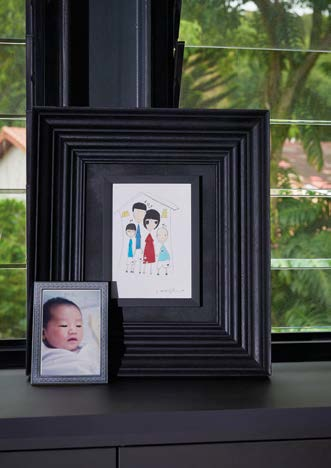This modern kampung house pushes the concept of communal living to the extreme. LYNN TAN finds out more about this interesting project from the team behind its design.


This modern kampung house pushes the concept of communal living to the extreme. LYNN TAN finds out more about this interesting project from the team behind its design.

LASTING IMPRESSION The house is over 8m tall, a height that is comparable to that of some three-storey homes, but it is only two storeys high. “We feel that two storeys are sufficient for our family’s needs. We also love the high ceiling,”
WHO LIVES HERE
A couple and their three children
HOME A semi-detached home in Jalan Wajek
SIZE 4,818sqf (land area), 6,474sqf (built-up area)

Alex and Pauline believe firmly in spending as much time as possible with their three boys, Ayden, Kaleb and Eli, aged 10, nine and seven months respectively, especially while they are young.
This semi-detached house at the corner of Jalan Wajek looks every bit the industrial home, with its black steel and glass exterior, complete with a corrugated metal roof more commonly used in the construction of flatted factories here. So it comes as a surprise when the team at Three-D Conceptwerke reveals that the design was not driven by any particular style.
“Together with the homeowners, we wanted a home that was open and airy, comprising a simple and lightweight structure,” says the team.
As a typical reinforced concrete structure would be visually too heavy, they decided to use I-sections for the columns and beams. Instead of covering up these structural members, they chose to express them, resulting in an aesthetic language that is a manifestation of the design ethos rather than style.
The choice of building elements also addressed the homeowners’ preference for a dry construction approach. Alex Lin and Pauline Soo were adamant about minimising disturbance to their neighbours, so the home was conceived with pre-fabrication in mind and without any piling involved.
A raft foundation was cast after the existing house was demolished, upon which the new house was erected. Structural members were calculated and pre-cut to size, then transported to site, and bolted and welded together like a Meccano toy set. Similarly, the corrugated metal was chosen as the roofing material because of the ease of installation and its durable qualities. Cutting down on insitu works also greatly reduced the construction time to 12 months, including planning and design. “The skeleton of the house went up very quickly. Whenever we came by the site to check on the progress, we could literally see the house ‘growing’ day by day,” recalls Alex.
This project was a challenge for the design studio, requiring meticulous planning before construction, as well as working very closely with the architect who advised them on building regulations and authority submission requirements. The result is a captivating domain with spaces that flow freely from room to room and designed to encourage social interaction.
“We see this project not so much as building a home for our clients, but more about building a dream and turning it into reality,” says the team.

AIR PLAY The many skylights allow natural light to filter into the house, giving the interior different qualities depending on the time of day. “I love how the house interacts with the light,” comments Alex. “We understand that there is always a link between light and heat, but this is something that we are willing to live with.”


INSIDE OUT The design team went through various proposals with Alex and Pauline, including a “kelong style” home elevated on “stilts”, and one with front and rear blocks connected by a central staircase, before eventually arriving at the final design, which is more reminiscent of a traditional kampung dwelling layout. But all the schemes had a common thread, which is the element of communal living.
THE OPEN MA STER BEDROOM LOOKS OUT TO ALE X'S STUDY, WHICH HE R EFERS TO AS HIS "MAN CAVE”.


SPACE TO THINK Two green armchairs in a cosy corner overlooking the driveway strike a dialogue with the landscaping around the compound, and inject colour into a monochromatic palette. Alex expressed some initial reservations about the colour monotony and austerity, but Pauline confidently forged ahead. Now, he really likes it. “I think the grey walls and floors really complement the black metal elements,” he says.

"A SKYLIGHT ABOVE ONE OF THE COMMON SHOWERS GIVES IT AN OUTDOOR FEEL."

Gym locker room-style showers are a unique feature of the home, which, again, draw on the theme of communal living.

The use of perforated metal panels reinforces the quality of lightness and casts interesting shadows.

The absence of the ubiquitous walk-in wardrobe is just one of the many ways that this home defies convention. Taking its place is a row of wardrobes that lines the wall beside the master bedroom.

The wide corridors are proportionate to the lofty ceiling height. Their generous width also transforms them from utilitarian circulation into communal spaces.

The aesthetics of the home are derived from an honest expression of how it has been put together with components that give it character, from the exposed structural I-section columns and beams, and Bondek formwork, to the ceiling cable trays, raw cement floor and industrial switches.

The Lins’ family home is filled with personalised touches and keepsakes that give it a warm and loving feel, despite its metallic structure and grey-black colour.

Instead of an attached master bathroom, the family shares a common cluster of WCs and showers.
Photography KOH BOONWEI Art Direction NONIE CHEN & KAFFY TAN























